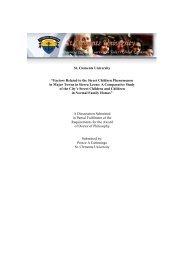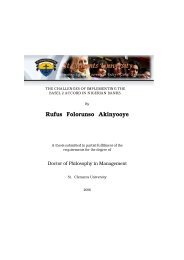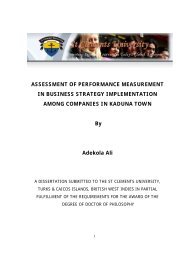The role of informal microfinance institutions in saving
The role of informal microfinance institutions in saving
The role of informal microfinance institutions in saving
You also want an ePaper? Increase the reach of your titles
YUMPU automatically turns print PDFs into web optimized ePapers that Google loves.
2.2.10.3 THE COMPARATIVE ANALYSIS BETWEEN TANZANIA’S SACCOs AND<br />
KENYA’S SACCOs<br />
1. Sect oral and supervisory authority for both countries come under cooperative law<br />
covered by bank<strong>in</strong>g law, although this does not clearly reflected <strong>in</strong> the attribution <strong>of</strong> a<br />
specific function to the central Bank or the m<strong>in</strong>istry <strong>of</strong> f<strong>in</strong>ance.<br />
2. Both countries lack <strong>of</strong> <strong>in</strong>teraction and exchange between the SACCOs and other<br />
Micr<strong>of</strong><strong>in</strong>ance <strong><strong>in</strong>stitutions</strong> and the victual non-existence <strong>of</strong> methodological cross –<br />
fertilization between the two types <strong>of</strong> <strong>in</strong>stitution i.e. they fail to receive <strong>in</strong>structions<br />
from the central Bank regard<strong>in</strong>g the preparations <strong>of</strong> f<strong>in</strong>ancial statements and the<br />
prudential norms to be observed.<br />
3. Membership pr<strong>of</strong>ile for the two countries have been standardized and has spread<br />
almost all <strong>of</strong> the parts <strong>of</strong> their countries as they share many basic features <strong>in</strong> the way are<br />
established, the pr<strong>of</strong>ile <strong>of</strong> their membership the f<strong>in</strong>ancial products <strong>of</strong>fered their structure<br />
and to a certa<strong>in</strong> extent to a degree <strong>of</strong> social and f<strong>in</strong>ancial viability id similar wherever<br />
they are established.<br />
4. Both countries, the SACCOs still enjoy a monopoly position <strong>in</strong> their market as they<br />
have been established <strong>in</strong> rural areas while the Micr<strong>of</strong><strong>in</strong>ance NGOs are more<br />
concentrated <strong>in</strong> urban centers.<br />
SACCOs serve cash crops formers <strong>in</strong> rural areas and salaried <strong>in</strong>dividuals <strong>in</strong> urban areas<br />
(school teacher for <strong>in</strong>stance), while micr<strong>of</strong><strong>in</strong>ance NGOs serve micro-entrepreneur <strong>in</strong><br />
towns and the banks serve formal enterprises and wealthy <strong>in</strong>dividuals<br />
SACCOs <strong>in</strong> both countries are not organized <strong>in</strong>to networks as the structure is divided<br />
<strong>in</strong>to two levels the SACCOs at the base with huge membership potential (hundred <strong>of</strong><br />
thousands <strong>of</strong> members and an apex structure directly above them at the national level<br />
with no <strong>in</strong>termediate body.<br />
139
















